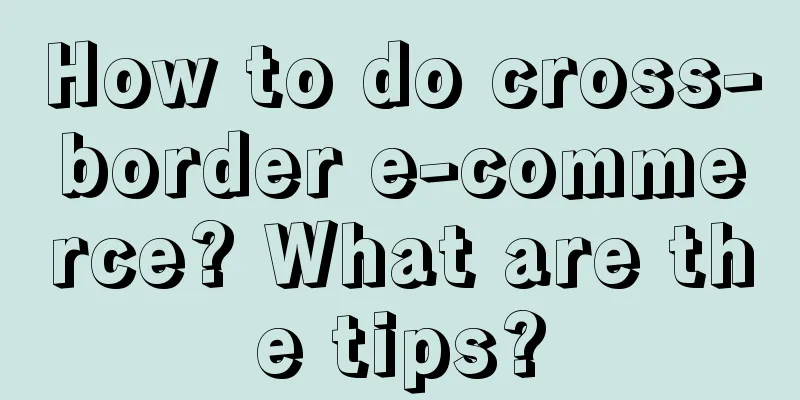What are the dedicated lines for cross-border e-commerce logistics? What are the logistics models?

|
With the rapid development of cross-border e-commerce, cross-border e-commerce logistics has become increasingly important. In order to meet consumers' demand for international goods, various dedicated logistics services have emerged. These dedicated logistics help e-commerce companies achieve global product supply and distribution by establishing an efficient and reliable logistics network and providing customized solutions. 1. What are the dedicated lines for cross-border e-commerce logistics? Cross-border e-commerce logistics dedicated lines refer to logistics services between two or more countries. The dedicated lines of cross-border e-commerce logistics mainly include the following: 1. China-US Special Line: The main transport commodities are electronic products, clothing, shoes and hats, etc. The transportation time is generally 7-15 days. 2. China-Russia special line: The main transport commodities are electronic products, clothing, shoes and hats, food, etc. The transportation time is generally 10-20 days. 3. China-Europe Special Line: The main transported goods are electronic products, clothing, shoes and hats, furniture, etc. The transportation time is generally 10-20 days. 4. China-Southeast Asia Special Line: The main transported goods are electronic products, clothing, shoes and hats, food, etc. The transportation time is generally 5-10 days. In addition to the above-mentioned special lines, there are also China-Middle East special lines, China-South America special lines, etc. The transportation time and transported goods of these special lines will vary depending on the region. 2. What are the logistics models? Cross-border e-commerce logistics models mainly include the following: 1. International small parcel: refers to sending goods directly from China to the destination country through international express companies. The advantages of this model are fast speed and high security, and the disadvantages are high cost and many restrictions. 2. International express delivery: refers to sending goods directly from China to the destination country through international express companies. The advantages of this model are fast speed and high security, while the disadvantages are high cost and many restrictions. 3. Overseas warehouse: refers to storing goods in warehouses in the destination country. When consumers place an order, the goods are shipped directly from the overseas warehouse. The advantages of this model are fast speed and low cost, and the disadvantage is that it requires certain storage costs. 4. International Post: refers to sending goods from China to the destination country through the postal services of various countries. The advantages of this model are low cost and wide coverage, and the disadvantages are slow speed and low security. The dedicated lines and modes of cross-border e-commerce logistics each have their own advantages and disadvantages. When choosing logistics services, merchants need to choose logistics services that suit them based on their actual situation and product characteristics to improve consumers' shopping experience and satisfaction. Recommended reading: Which platform should I choose for my personal cross-border e-commerce business? What are the requirements for entry? How much does it cost for personal cross-border e-commerce? Do I need a deposit? Can cross-border e-commerce personal trademarks be registered? What are the regulations? |
Recommend
Why is Amazon not delivering orders? What can I do?
Now more and more merchants are opening stores on ...
Xiabu Xiabu: It claims to surpass Haidilao, build 5 million paying members, and earn 1 billion yuan a year from membership fees alone. What is the secret of its membership success?
Why was He Guangqi, the founder of Buxiabu, able t...
How many chances does Amazon have to pass the video verification? What are the precautions for video verification?
Generally, Amazon video verification is triggered ...
What is the process of listing products on Lazada? How does Lazada deliver products quickly?
The current development of Lazad cross-border e-co...
What should I do if the KYC audit of Amazon Europe is rejected? Detailed answer
If an Amazon merchant changes the legal person inf...
Are eBay's logistics standards too harsh? What is eBay's current official logistics?
Some people think that eBay's logistics standa...
How to apply for VAT on Amazon Europe? How much VAT should be paid?
To open a European store on Amazon, you need to re...
"Listen" has been quietly tested for half a year, and WeChat has secretly created a "small universe"
An article on a public account can have a readersh...
The total number of online views exceeds 500 million. This generation of young people has a strong sense of stealing
On the Internet, the term "stealing feeling&q...
Why does the market still need a JD Takeaway?
In February 2025, JD.com officially increased its ...
How do buyers place orders on Amazon without a shopping cart? How can I get one?
There are many friends who have opened stores on A...
Xiaohongshu shuts down its “self-operated e-commerce platform”, what is its plan?
Recently, Xiaohongshu closed its self-operated e-c...
How to design the "live broadcast" plot in online articles?
Live broadcast plot creation: Use online writing r...
Will Amazon keywords be associated in the same way? What is the impact of association?
After opening a store on Amazon, you may choose th...
How to set up free shipping on Shopee Taiwan? How to operate the site?
Now more and more merchants are opening stores on ...









